Carbon Nanotube Market Size 2025-2029
The carbon nanotube market size is valued to increase USD 36.25 billion, at a CAGR of 39.2% from 2024 to 2029. Miniaturization of semiconductor components will drive the carbon nanotube market.
Major Market Trends & Insights
- APAC dominated the market and accounted for a 57% growth during the forecast period.
- By Product - MWCNT segment was valued at USD 3.16 billion in 2023
- By Application - CPC segment accounted for the largest market revenue share in 2023
Market Size & Forecast
- Market Opportunities: USD 955.27 million
- Market Future Opportunities: USD 36251.40 million
- CAGR from 2024 to 2029 : 39.2%
Market Summary
- The market represents a dynamic and evolving domain, characterized by continuous innovation and advancements in core technologies and applications. This burgeoning market is driven by the miniaturization of semiconductor components and the growing demand for carbon nanotube-based touchscreens. However, the toxic nature of carbon nanotubes poses significant challenges, necessitating stringent regulations. According to recent reports, the carbon nanotube industry is projected to account for over 20% of the total nanomaterial market share by 2025, underscoring its immense potential.
- Despite these opportunities, the market faces hurdles such as production costs and environmental concerns. As this market unfolds, stakeholders must navigate these challenges and capitalize on the latest trends to remain competitive.
What will be the Size of the Carbon Nanotube Market during the forecast period?
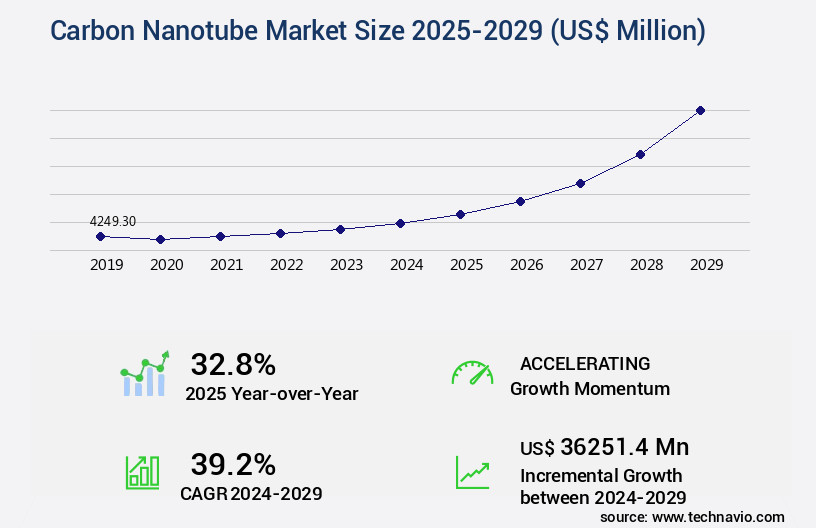
Get Key Insights on Market Forecast (PDF) Request Free Sample
How is the Carbon Nanotube Market Segmented ?
The carbon nanotube industry research report provides comprehensive data (region-wise segment analysis), with forecasts and estimates in "USD million" for the period 2025-2029, as well as historical data from 2019-2023 for the following segments.
- Product
- Application
- Method
- Chemical vapor deposition
- Catalytic chemical vapor deposition
- High-pressure carbon monoxide reaction
- Others
- Geography
- North America
- Europe
- APAC
- Australia
- China
- India
- Japan
- South Korea
- Rest of World (ROW)
By Product Insights
The mwcnt segment is estimated to witness significant growth during the forecast period.
Carbon nanotubes (CNTs), specifically multi-walled carbon nanotubes (MWCNTs), are gaining significant attention in various industries due to their unique properties. MWCNTs, consisting of multiple cylindrical-shaped tubes, have a diameter of approximately 30 nm, with the number of concentric walls ranging from 6 nm to 25 nm or more. MWCNTs' electrical properties make them highly conductive when integrated into composite structures, with the outer wall conducting electricity and the inner walls remaining insulating. In the realm of physical properties, MWCNTs exhibit remarkable tensile strength when combined with thermoplastics, leading to enhanced material strength. The applications of MWCNTs are vast and continually evolving.
In the field of catalytic activity, MWCNTs are employed as catalyst supports due to their high surface area and structural characterization techniques like electron microscopy, Raman spectroscopy, and X-ray diffraction are used to analyze their properties. MWCNTs also find extensive use in tissue engineering scaffolds, providing enhanced mechanical strength and electrical conductivity. In the realm of wearable sensors, nanotube dispersion techniques are used to create flexible, lightweight, and durable sensors. Moreover, MWCNTs' high surface area and diameter distribution analysis contribute to their use in energy storage applications, such as batteries and supercapacitors. In the realm of flexible electronics, MWCNTs' electrical resistivity and thermal conductivity make them suitable for use in electronic device integration.
MWCNTs' chemical stability and thermal stability are crucial factors in their use in composite materials, such as CNT film fabrication, which results in materials with high flexural strength and field emission properties. Surface functionalization methods are used to enhance the electrical conductivity and mechanical strength properties of MWCNTs. The market for MWCNTs is expected to grow substantially, with an estimated 18.5% of the global nanomaterials market share in 2021. Furthermore, the market is projected to reach a value of USD13.3 billion by 2028, growing at a rate of 15.1% annually during the forecast period. These trends reflect the continuous and evolving nature of the market and its applications across various sectors.
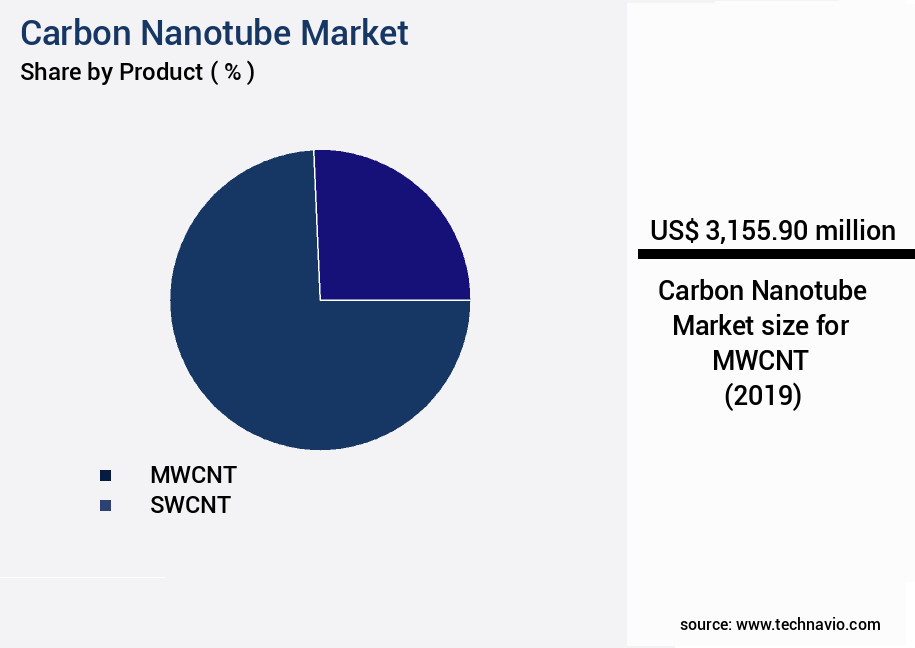
Request Free Sample
The MWCNT segment was valued at USD 3.16 billion in 2019 and showed a gradual increase during the forecast period.
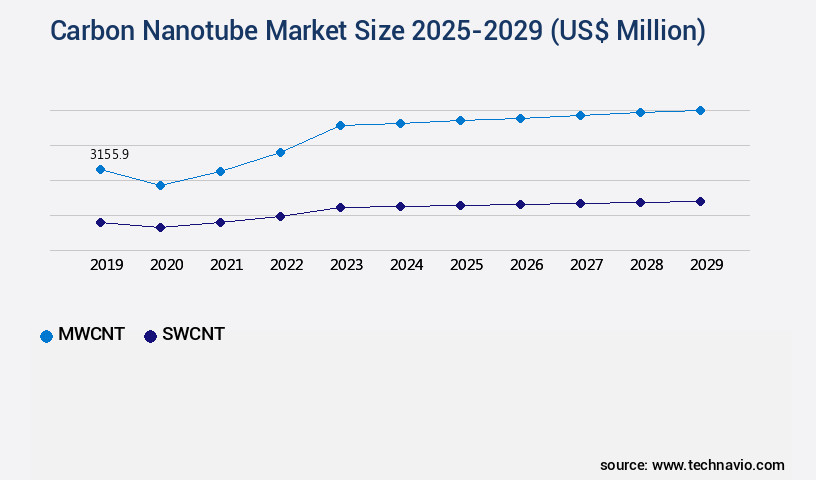
Request Free Sample
Regional Analysis
APAC is estimated to contribute 57% to the growth of the global market during the forecast period.Technavio’s analysts have elaborately explained the regional trends and drivers that shape the market during the forecast period.
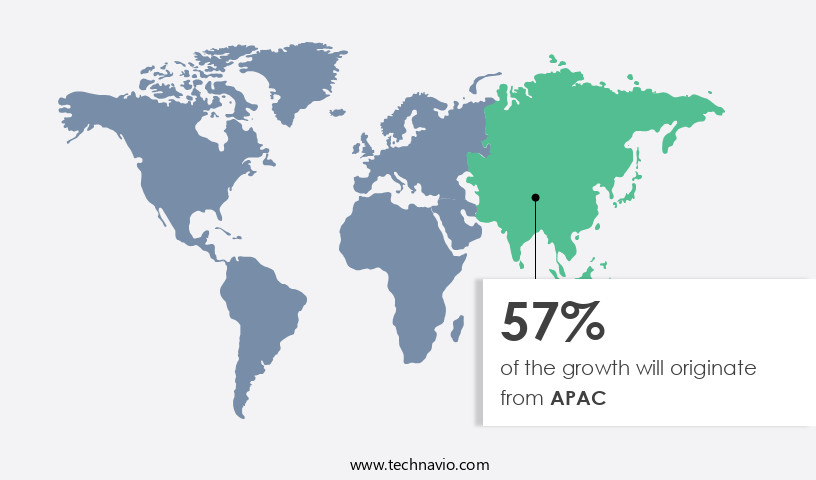
See How Carbon Nanotube Market Demand is Rising in APAC Request Free Sample
The Asia-Pacific region's the market dominance is driven by the presence of a significant number of manufacturers in the area. Carbon nanotubes are essential for producing supercapacitors, which find applications in electric vehicles, satellites, and other sectors. China is a global leader in graphene and carbon nanotube research, fueled by supportive government policies, funding, and cutting-edge academic studies. Moreover, the expanding plastic and composite industries in China and India, spurred by increasing domestic demand, are projected to boost carbon nanotube demand.
Market Dynamics
Our researchers analyzed the data with 2024 as the base year, along with the key drivers, trends, and challenges. A holistic analysis of drivers will help companies refine their marketing strategies to gain a competitive advantage.
The global carbon nanotube (CNT) market encompasses a diverse range of applications, from enhancing mechanical properties in composites to improving thermal conductivity in electronics. One significant application area is the use of CNTs in epoxy resins, where their unique dispersion properties contribute to superior electrical conductivity. The length of the nanotubes plays a crucial role in their conductivity, with shorter nanotubes offering higher electrical conductivity. CNTs also find extensive use in lithium-ion batteries, where they improve energy density and charge/discharge rates. Thermal conductivity is another key area of interest, with CNT-based composites exhibiting superior thermal conductivity, making them suitable for high-performance applications.
Chirality, a critical factor in CNT synthesis, significantly influences their electrical performance. Various synthesis methods, such as chemical vapor deposition and arc discharge, are employed to produce high-purity CNTs. Characterization techniques like Raman spectroscopy are essential for evaluating the quality and properties of CNT films. Surface functionalization is a crucial aspect of CNT applications, as it enhances their dispersion in various matrices and enables new applications. For instance, drug delivery systems using functionalized CNTs have shown promise in the biomedical field. CNT-based sensors for environmental monitoring and flexible electronics applications are other emerging areas of research. The mechanical strength of CNT-reinforced polymers is another significant application, with these materials offering enhanced properties compared to their conventional counterparts.
In the energy sector, CNTs are being explored for hydrogen storage applications due to their high surface area and excellent adsorption properties. Despite the numerous benefits, the biocompatibility evaluation of CNT scaffolds remains a critical challenge in the biomedical field. The market for CNTs is highly competitive, with numerous players focusing on improving thermal stability and enhancing electrical conductivity in their composites. Compared to traditional reinforcements, the market share of CNTs in high-performance applications is growing rapidly. For instance, the adoption rates of CNT-based electrodes in energy storage applications are nearly double those of conventional electrodes. This trend is expected to continue, driven by the ongoing research and development efforts in this area.
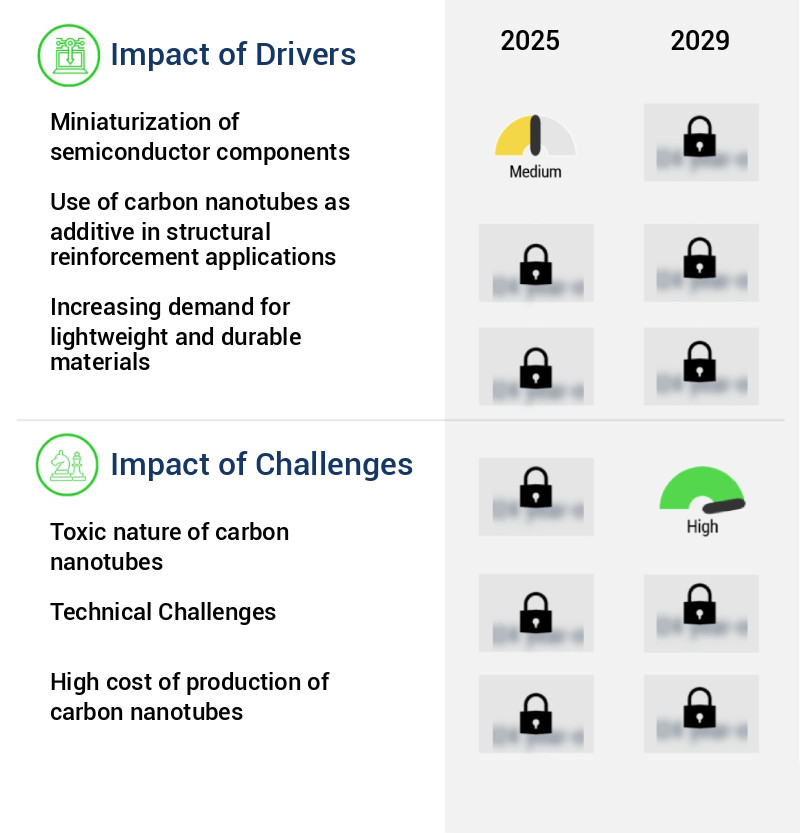
What are the key market drivers leading to the rise in the adoption of Carbon Nanotube Industry?
- The miniaturization of semiconductor components serves as the primary catalyst for market growth. This trend, driven by advancements in technology and manufacturing processes, enables the production of smaller, more efficient, and cost-effective electronic devices.
- One significant market trend is the increasing emphasis on the manufacture of miniaturized components. The production of these components has experienced substantial growth, making them a crucial element in numerous consumer electronics. Miniaturization continues to be a pivotal force shaping the electronics sector. Components are being engineered to nanoscale dimensions, enabling a higher density of surface mount devices (SMDs) on a printed circuit board (PCB).
- This leads to the addition of more functionalities and a reduction in the size of PCBs. Miniaturization is evident in various devices, from mobile phones to computers, automotive engines, and even charging adapters. This ongoing process of shrinking components' physical dimensions enhances the overall efficiency and functionality of electronic devices.
What are the market trends shaping the Carbon Nanotube Industry?
- The increasing demand for carbon nanotube-based touchscreens represents a significant market trend in the technology industry.
Carbon nanotubes offer enhanced sensitivity and responsiveness, making them an attractive alternative to traditional touchscreen technologies.
- Touchscreens have revolutionized mobile device input, replacing traditional push-button and physical keypads with simpler and more intuitive interfaces. Initially, touchscreens were predominantly made of indium oxide (ITO) doped with tin. However, recent advancements have led to the adoption of single-wall carbon nanotubes (SWCNTs) in touchscreen production. SWCNTs offer several advantages over ITO-based materials. For instance, a single SWCNT is 99% transparent, making it an ideal choice for touchscreens in various applications, including ATMs, kiosks, televisions, and monitors. Furthermore, SWCNTs have a higher electrical conductivity, enabling faster response times and improved touchscreen sensitivity.
- The transition from ITO to SWCNTs represents a significant shift in touchscreen technology. This change is not limited to mobile devices but also extends to other industries such as healthcare, retail, and entertainment. As touchscreens become increasingly ubiquitous, their applications continue to evolve, offering new opportunities for businesses and consumers alike.
What challenges does the Carbon Nanotube Industry face during its growth?
- The toxicity of carbon nanotubes poses a significant challenge to the growth of the industry, necessitating rigorous research and development efforts to mitigate potential health and environmental risks associated with their production and application.
- The market in the healthcare sector faces a significant challenge due to the health risks associated with their production. The toxicity of carbon nanotubes poses a threat to workers in manufacturing facilities, making it a critical issue to address. Researchers worldwide are investigating the impact of carbon nanotubes on human health to mitigate these risks. For instance, scientists at the University of Edinburgh discovered that short carbon nanotubes exhibit no harm to the human body. This finding offers a potential solution to the toxicity issue, which could boost the adoption of carbon nanotubes in the healthcare sector.
- Despite this challenge, the market continues to evolve, with ongoing research and development efforts aimed at reducing the production-related health risks. The potential applications of carbon nanotubes in healthcare are vast, including drug delivery systems, biosensors, and tissue engineering. This data-driven narrative highlights the continuous nature of the market and its significance across various sectors, emphasizing the importance of ongoing research and innovation to address the challenges and unlock new opportunities.
Exclusive Technavio Analysis on Customer Landscape
The carbon nanotube market forecasting report includes the adoption lifecycle of the market, covering from the innovator’s stage to the laggard’s stage. It focuses on adoption rates in different regions based on penetration. Furthermore, the carbon nanotube market report also includes key purchase criteria and drivers of price sensitivity to help companies evaluate and develop their market growth analysis strategies.
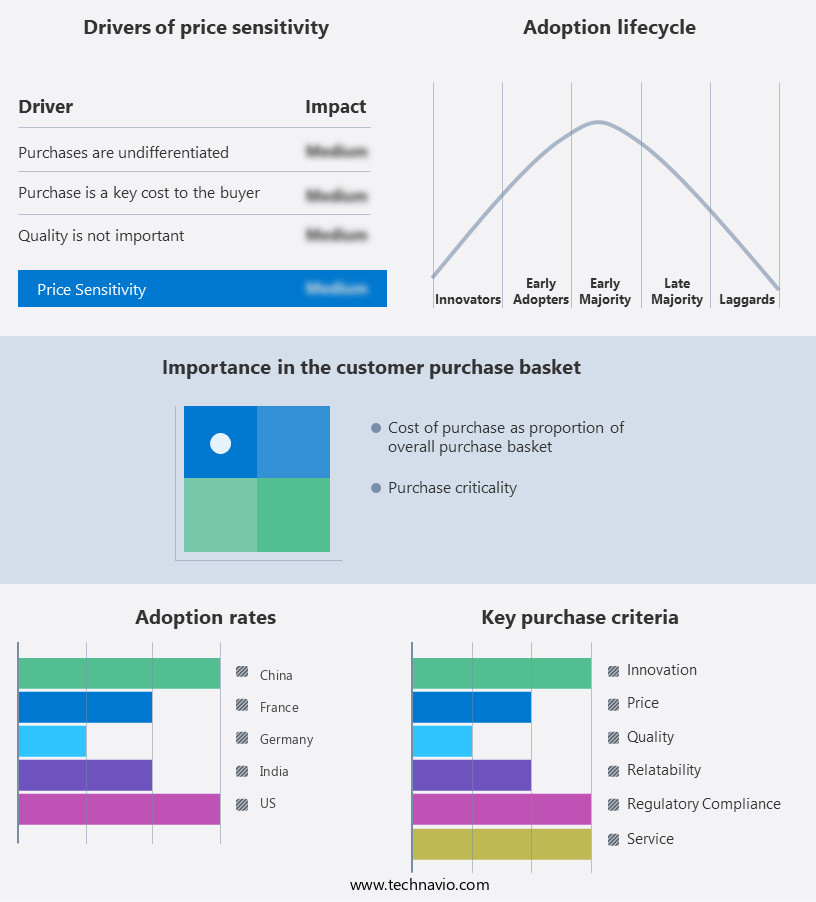
Customer Landscape of Carbon Nanotube Industry
Competitive Landscape
Companies are implementing various strategies, such as strategic alliances, carbon nanotube market forecast, partnerships, mergers and acquisitions, geographical expansion, and product/service launches, to enhance their presence in the industry.
Arkema - The company specializes in the production of Graphistrength carbon nanotubes, renowned for delivering exceptional electrostatic dissipation properties at minimal concentration levels. These advanced nanomaterials significantly enhance product performance in various industries.
The industry research and growth report includes detailed analyses of the competitive landscape of the market and information about key companies, including:
- Arkema
- Cabot Corp.
- Carbon Solutions Inc.
- CHASM Advanced Materials Inc.
- Continental Carbon Co.
- Hanwha Corp.
- Hyperion Catalysis International Inc.
- Jiangsu Cnano Technology Co. Ltd.
- Klean Industries Inc.
- LG Chem Ltd.
- Nano C Inc.
- Nanocyl SA
- Nanoshel LLC
- NoPo Nanotechnologies India Pvt. Ltd.
- OCSiAl
- Ossila Ltd.
- Raymor Industries Inc.
- Resonac Holdings Corp.
- Toray Industries Inc.
Qualitative and quantitative analysis of companies has been conducted to help clients understand the wider business environment as well as the strengths and weaknesses of key industry players. Data is qualitatively analyzed to categorize companies as pure play, category-focused, industry-focused, and diversified; it is quantitatively analyzed to categorize companies as dominant, leading, strong, tentative, and weak.
Recent Development and News in Carbon Nanotube Market
- In January 2024, Hanwha Chemical, a leading South Korean materials company, announced the commercialization of its mass-produced single-wall carbon nanotube (SWCNT) product, Hanbicarb CNT-100, for use in various industries, including electronics, energy, and automotive sectors (Hanwha Chemical press release).
- In March 2024, Tesla, the American electric vehicle manufacturer, and Carbon3D, a carbon nanotube technology company, entered into a strategic partnership to research and develop advanced materials for batteries and supercapacitors, aiming to enhance energy storage systems' performance and reduce production costs (Tesla press release).
- In May 2024, the European Union's Horizon Europe research and innovation program granted a €3.5 million (USD3.9 million USD) funding to a consortium led by the University of Manchester to develop a large-scale manufacturing process for carbon nanotubes and integrate them into various applications, such as energy storage, sensors, and composites (European Commission press release).
- In April 2025, Nanotech Energy, a US-based carbon nanotube technology company, announced the successful production of a 100 MW hour (MWh) supercapacitor using its proprietary carbon nanotube material, marking a significant milestone in energy storage technology and positioning the company as a key player in the market (Nanotech Energy press release).
Dive into Technavio’s robust research methodology, blending expert interviews, extensive data synthesis, and validated models for unparalleled Carbon Nanotube Market insights. See full methodology.
|
Market Scope
|
|
Report Coverage
|
Details
|
|
Page number
|
229
|
|
Base year
|
2024
|
|
Historic period
|
2019-2023 |
|
Forecast period
|
2025-2029
|
|
Growth momentum & CAGR
|
Accelerate at a CAGR of 39.2%
|
|
Market growth 2025-2029
|
USD 36251.4 million
|
|
Market structure
|
Fragmented
|
|
YoY growth 2024-2025(%)
|
32.8
|
|
Key countries
|
US, China, India, Japan, South Korea, Germany, France, Australia, Canada, and UK
|
|
Competitive landscape
|
Leading Companies, Market Positioning of Companies, Competitive Strategies, and Industry Risks
|
Request Free Sample
Research Analyst Overview
- The carbon nanotube (CNT) market is characterized by continuous catalytic activity, driving the exploration of new applications and advancements in CNT synthesis methods. One significant area of growth is in tissue engineering scaffolds, where CNTs' high surface area and mechanical strength properties make them ideal for enhancing cell adhesion and promoting tissue regeneration. In the realm of material science, atomic force microscopy and Raman spectroscopy are essential tools for structural characterization, enabling researchers to analyze diameter distribution and chirality of CNTs. Advancements in CNT synthesis techniques have led to improved impact resistance, purification protocols, and fiber spinning techniques, making CNT composite materials increasingly viable for applications in flexible electronics and energy storage.
- Moreover, CNTs' high tensile strength, electrical resistivity, and thermal stability have led to their integration into wearable sensors, enabling real-time health monitoring and improving overall performance. Nanotube dispersion techniques have also been refined, allowing for the production of high-quality CNT films through fabrication processes such as chemical vapor deposition and solution processing. CNTs' field emission properties and surface functionalization methods have opened new avenues for electronic device integration, particularly in the development of high-performance transistors and sensors. Furthermore, CNTs' chemical stability and thermal conductivity measurement have made them indispensable in various applications, including drug delivery systems and sensor applications.
- Defect density analysis and electrical conductivity testing continue to be crucial aspects of CNT research, as understanding the impact of defects on CNT properties and finding ways to mitigate their effects remains a key challenge. Overall, the market is a dynamic and evolving landscape, with ongoing research and development leading to new applications and advancements in this versatile material.
What are the Key Data Covered in this Carbon Nanotube Market Research and Growth Report?
-
What is the expected growth of the Carbon Nanotube Market between 2025 and 2029?
-
What segmentation does the market report cover?
-
The report is segmented by Product (MWCNT and SWCNT), Application (CPC, Electronics, EBC, and Others), Method (Chemical vapor deposition, Catalytic chemical vapor deposition, High-pressure carbon monoxide reaction, and Others), and Geography (APAC, North America, Europe, Middle East and Africa, and South America)
-
Which regions are analyzed in the report?
-
APAC, North America, Europe, Middle East and Africa, and South America
-
What are the key growth drivers and market challenges?
-
Who are the major players in the Carbon Nanotube Market?
-
Arkema, Cabot Corp., Carbon Solutions Inc., CHASM Advanced Materials Inc., Continental Carbon Co., Hanwha Corp., Hyperion Catalysis International Inc., Jiangsu Cnano Technology Co. Ltd., Klean Industries Inc., LG Chem Ltd., Nano C Inc., Nanocyl SA, Nanoshel LLC, NoPo Nanotechnologies India Pvt. Ltd., OCSiAl, Ossila Ltd., Raymor Industries Inc., Resonac Holdings Corp., and Toray Industries Inc.
Market Research Insights
- The market encompasses a diverse range of applications, including nanoelectronics devices, mechanical properties enhancement for automotive parts, and environmental applications. According to industry estimates, the market for carbon nanotubes is projected to reach USD1.3 billion by 2025, representing a compound annual growth rate of 18%. This growth is driven by the unique electrical and thermal properties of carbon nanotubes, such as high conductivity, band gap engineering, and thermal management. Carbon nanotubes' mechanical properties, including their high aspect ratio and strength reinforcement, have led to their adoption in aerospace composites and reinforced concrete. In addition, carbon nanotubes exhibit excellent electrochemical performance in fuel cells, making them a promising material for energy storage and conversion systems.
- Furthermore, carbon nanotubes' hydrogen storage capacity, biocompatibility, and gas sensing properties have significant potential in biomedical applications and water purification. The integration of carbon nanotubes in optical properties, thermal properties, and chemical modifications has expanded their applications in various industries, including electronics, thermal management, and filtration membranes. The continuous research and development efforts in defect engineering and graphene nanotube hybrids are expected to further broaden the market scope and potential applications of carbon nanotubes.
We can help! Our analysts can customize this carbon nanotube market research report to meet your requirements.
Get in touch
1 Executive Summary
- 1.1 Market overview
- Executive Summary - Chart on Market Overview
- Executive Summary - Data Table on Market Overview
- Executive Summary - Chart on Global Market Characteristics
- Executive Summary - Chart on Market by Geography
- Executive Summary - Chart on Market Segmentation by Product
- Executive Summary - Chart on Market Segmentation by Application
- Executive Summary - Chart on Market Segmentation by Method
- Executive Summary - Chart on Incremental Growth
- Executive Summary - Data Table on Incremental Growth
- Executive Summary - Chart on Company Market Positioning
2 Technavio Analysis
- 2.1 Analysis of price sensitivity, lifecycle, customer purchase basket, adoption rates, and purchase criteria
- Analysis of price sensitivity, lifecycle, customer purchase basket, adoption rates, and purchase criteria
- 2.2 Criticality of inputs and Factors of differentiation
- Overview on criticality of inputs and factors of differentiation
- 2.3 Factors of disruption
- Overview on factors of disruption
- 2.4 Impact of drivers and challenges
- Impact of drivers and challenges in 2024 and 2029
3 Market Landscape
- 3.1 Market ecosystem
- Parent Market
- Data Table on - Parent Market
- 3.2 Market characteristics
- Market characteristics analysis
4 Market Sizing
- 4.1 Market definition
- Offerings of companies included in the market definition
- 4.2 Market segment analysis
- 4.4 Market outlook: Forecast for 2024-2029
- Chart on Global - Market size and forecast 2024-2029 ($ million)
- Data Table on Global - Market size and forecast 2024-2029 ($ million)
- Chart on Global Market: Year-over-year growth 2024-2029 (%)
- Data Table on Global Market: Year-over-year growth 2024-2029 (%)
5 Historic Market Size
- 5.1 Global Carbon Nanotube Market 2019 - 2023
- Historic Market Size - Data Table on Global Carbon Nanotube Market 2019 - 2023 ($ million)
- 5.2 Product segment analysis 2019 - 2023
- Historic Market Size - Product Segment 2019 - 2023 ($ million)
- 5.3 Application segment analysis 2019 - 2023
- Historic Market Size - Application Segment 2019 - 2023 ($ million)
- 5.4 Method segment analysis 2019 - 2023
- Historic Market Size - Method Segment 2019 - 2023 ($ million)
- 5.5 Geography segment analysis 2019 - 2023
- Historic Market Size - Geography Segment 2019 - 2023 ($ million)
- 5.6 Country segment analysis 2019 - 2023
- Historic Market Size - Country Segment 2019 - 2023 ($ million)
6 Qualitative Analysis
- 6.1 The AI impact on Global Carbon Nanotube Market
7 Five Forces Analysis
- 7.1 Five forces summary
- Five forces analysis - Comparison between 2024 and 2029
- 7.2 Bargaining power of buyers
- Bargaining power of buyers - Impact of key factors 2024 and 2029
- 7.3 Bargaining power of suppliers
- Bargaining power of suppliers - Impact of key factors in 2024 and 2029
- 7.4 Threat of new entrants
- Threat of new entrants - Impact of key factors in 2024 and 2029
- 7.5 Threat of substitutes
- Threat of substitutes - Impact of key factors in 2024 and 2029
- 7.6 Threat of rivalry
- Threat of rivalry - Impact of key factors in 2024 and 2029
- 7.7 Market condition
- Chart on Market condition - Five forces 2024 and 2029
8 Market Segmentation by Product
- 8.1 Market segments
- Chart on Product - Market share 2024-2029 (%)
- Data Table on Product - Market share 2024-2029 (%)
- 8.2 Comparison by Product
- Chart on Comparison by Product
- Data Table on Comparison by Product
- 8.3 MWCNT - Market size and forecast 2024-2029
- Chart on MWCNT - Market size and forecast 2024-2029 ($ million)
- Data Table on MWCNT - Market size and forecast 2024-2029 ($ million)
- Chart on MWCNT - Year-over-year growth 2024-2029 (%)
- Data Table on MWCNT - Year-over-year growth 2024-2029 (%)
- 8.4 SWCNT - Market size and forecast 2024-2029
- Chart on SWCNT - Market size and forecast 2024-2029 ($ million)
- Data Table on SWCNT - Market size and forecast 2024-2029 ($ million)
- Chart on SWCNT - Year-over-year growth 2024-2029 (%)
- Data Table on SWCNT - Year-over-year growth 2024-2029 (%)
- 8.5 Market opportunity by Product
- Market opportunity by Product ($ million)
- Data Table on Market opportunity by Product ($ million)
9 Market Segmentation by Application
- 9.1 Market segments
- Chart on Application - Market share 2024-2029 (%)
- Data Table on Application - Market share 2024-2029 (%)
- 9.2 Comparison by Application
- Chart on Comparison by Application
- Data Table on Comparison by Application
- 9.3 CPC - Market size and forecast 2024-2029
- Chart on CPC - Market size and forecast 2024-2029 ($ million)
- Data Table on CPC - Market size and forecast 2024-2029 ($ million)
- Chart on CPC - Year-over-year growth 2024-2029 (%)
- Data Table on CPC - Year-over-year growth 2024-2029 (%)
- 9.4 Electronics - Market size and forecast 2024-2029
- Chart on Electronics - Market size and forecast 2024-2029 ($ million)
- Data Table on Electronics - Market size and forecast 2024-2029 ($ million)
- Chart on Electronics - Year-over-year growth 2024-2029 (%)
- Data Table on Electronics - Year-over-year growth 2024-2029 (%)
- 9.5 EBC - Market size and forecast 2024-2029
- Chart on EBC - Market size and forecast 2024-2029 ($ million)
- Data Table on EBC - Market size and forecast 2024-2029 ($ million)
- Chart on EBC - Year-over-year growth 2024-2029 (%)
- Data Table on EBC - Year-over-year growth 2024-2029 (%)
- 9.6 Others - Market size and forecast 2024-2029
- Chart on Others - Market size and forecast 2024-2029 ($ million)
- Data Table on Others - Market size and forecast 2024-2029 ($ million)
- Chart on Others - Year-over-year growth 2024-2029 (%)
- Data Table on Others - Year-over-year growth 2024-2029 (%)
- 9.7 Market opportunity by Application
- Market opportunity by Application ($ million)
- Data Table on Market opportunity by Application ($ million)
10 Market Segmentation by Method
- 10.1 Market segments
- Chart on Method - Market share 2024-2029 (%)
- Data Table on Method - Market share 2024-2029 (%)
- 10.2 Comparison by Method
- Chart on Comparison by Method
- Data Table on Comparison by Method
- 10.3 Chemical vapor deposition - Market size and forecast 2024-2029
- Chart on Chemical vapor deposition - Market size and forecast 2024-2029 ($ million)
- Data Table on Chemical vapor deposition - Market size and forecast 2024-2029 ($ million)
- Chart on Chemical vapor deposition - Year-over-year growth 2024-2029 (%)
- Data Table on Chemical vapor deposition - Year-over-year growth 2024-2029 (%)
- 10.4 Catalytic chemical vapor deposition - Market size and forecast 2024-2029
- Chart on Catalytic chemical vapor deposition - Market size and forecast 2024-2029 ($ million)
- Data Table on Catalytic chemical vapor deposition - Market size and forecast 2024-2029 ($ million)
- Chart on Catalytic chemical vapor deposition - Year-over-year growth 2024-2029 (%)
- Data Table on Catalytic chemical vapor deposition - Year-over-year growth 2024-2029 (%)
- 10.5 High-pressure carbon monoxide reaction - Market size and forecast 2024-2029
- Chart on High-pressure carbon monoxide reaction - Market size and forecast 2024-2029 ($ million)
- Data Table on High-pressure carbon monoxide reaction - Market size and forecast 2024-2029 ($ million)
- Chart on High-pressure carbon monoxide reaction - Year-over-year growth 2024-2029 (%)
- Data Table on High-pressure carbon monoxide reaction - Year-over-year growth 2024-2029 (%)
- 10.6 Others - Market size and forecast 2024-2029
- Chart on Others - Market size and forecast 2024-2029 ($ million)
- Data Table on Others - Market size and forecast 2024-2029 ($ million)
- Chart on Others - Year-over-year growth 2024-2029 (%)
- Data Table on Others - Year-over-year growth 2024-2029 (%)
- 10.7 Market opportunity by Method
- Market opportunity by Method ($ million)
- Data Table on Market opportunity by Method ($ million)
11 Customer Landscape
- 11.1 Customer landscape overview
- Analysis of price sensitivity, lifecycle, customer purchase basket, adoption rates, and purchase criteria
12 Geographic Landscape
- 12.1 Geographic segmentation
- Chart on Market share by geography 2024-2029 (%)
- Data Table on Market share by geography 2024-2029 (%)
- 12.2 Geographic comparison
- Chart on Geographic comparison
- Data Table on Geographic comparison
- 12.3 APAC - Market size and forecast 2024-2029
- Chart on APAC - Market size and forecast 2024-2029 ($ million)
- Data Table on APAC - Market size and forecast 2024-2029 ($ million)
- Chart on APAC - Year-over-year growth 2024-2029 (%)
- Data Table on APAC - Year-over-year growth 2024-2029 (%)
- 12.4 North America - Market size and forecast 2024-2029
- Chart on North America - Market size and forecast 2024-2029 ($ million)
- Data Table on North America - Market size and forecast 2024-2029 ($ million)
- Chart on North America - Year-over-year growth 2024-2029 (%)
- Data Table on North America - Year-over-year growth 2024-2029 (%)
- 12.5 Europe - Market size and forecast 2024-2029
- Chart on Europe - Market size and forecast 2024-2029 ($ million)
- Data Table on Europe - Market size and forecast 2024-2029 ($ million)
- Chart on Europe - Year-over-year growth 2024-2029 (%)
- Data Table on Europe - Year-over-year growth 2024-2029 (%)
- 12.6 Middle East and Africa - Market size and forecast 2024-2029
- Chart on Middle East and Africa - Market size and forecast 2024-2029 ($ million)
- Data Table on Middle East and Africa - Market size and forecast 2024-2029 ($ million)
- Chart on Middle East and Africa - Year-over-year growth 2024-2029 (%)
- Data Table on Middle East and Africa - Year-over-year growth 2024-2029 (%)
- 12.7 South America - Market size and forecast 2024-2029
- Chart on South America - Market size and forecast 2024-2029 ($ million)
- Data Table on South America - Market size and forecast 2024-2029 ($ million)
- Chart on South America - Year-over-year growth 2024-2029 (%)
- Data Table on South America - Year-over-year growth 2024-2029 (%)
- 12.8 US - Market size and forecast 2024-2029
- Chart on US - Market size and forecast 2024-2029 ($ million)
- Data Table on US - Market size and forecast 2024-2029 ($ million)
- Chart on US - Year-over-year growth 2024-2029 (%)
- Data Table on US - Year-over-year growth 2024-2029 (%)
- 12.9 China - Market size and forecast 2024-2029
- Chart on China - Market size and forecast 2024-2029 ($ million)
- Data Table on China - Market size and forecast 2024-2029 ($ million)
- Chart on China - Year-over-year growth 2024-2029 (%)
- Data Table on China - Year-over-year growth 2024-2029 (%)
- 12.10 India - Market size and forecast 2024-2029
- Chart on India - Market size and forecast 2024-2029 ($ million)
- Data Table on India - Market size and forecast 2024-2029 ($ million)
- Chart on India - Year-over-year growth 2024-2029 (%)
- Data Table on India - Year-over-year growth 2024-2029 (%)
- 12.11 Japan - Market size and forecast 2024-2029
- Chart on Japan - Market size and forecast 2024-2029 ($ million)
- Data Table on Japan - Market size and forecast 2024-2029 ($ million)
- Chart on Japan - Year-over-year growth 2024-2029 (%)
- Data Table on Japan - Year-over-year growth 2024-2029 (%)
- 12.12 South Korea - Market size and forecast 2024-2029
- Chart on South Korea - Market size and forecast 2024-2029 ($ million)
- Data Table on South Korea - Market size and forecast 2024-2029 ($ million)
- Chart on South Korea - Year-over-year growth 2024-2029 (%)
- Data Table on South Korea - Year-over-year growth 2024-2029 (%)
- 12.13 Germany - Market size and forecast 2024-2029
- Chart on Germany - Market size and forecast 2024-2029 ($ million)
- Data Table on Germany - Market size and forecast 2024-2029 ($ million)
- Chart on Germany - Year-over-year growth 2024-2029 (%)
- Data Table on Germany - Year-over-year growth 2024-2029 (%)
- 12.14 France - Market size and forecast 2024-2029
- Chart on France - Market size and forecast 2024-2029 ($ million)
- Data Table on France - Market size and forecast 2024-2029 ($ million)
- Chart on France - Year-over-year growth 2024-2029 (%)
- Data Table on France - Year-over-year growth 2024-2029 (%)
- 12.15 Australia - Market size and forecast 2024-2029
- Chart on Australia - Market size and forecast 2024-2029 ($ million)
- Data Table on Australia - Market size and forecast 2024-2029 ($ million)
- Chart on Australia - Year-over-year growth 2024-2029 (%)
- Data Table on Australia - Year-over-year growth 2024-2029 (%)
- 12.16 Canada - Market size and forecast 2024-2029
- Chart on Canada - Market size and forecast 2024-2029 ($ million)
- Data Table on Canada - Market size and forecast 2024-2029 ($ million)
- Chart on Canada - Year-over-year growth 2024-2029 (%)
- Data Table on Canada - Year-over-year growth 2024-2029 (%)
- 12.17 UK - Market size and forecast 2024-2029
- Chart on UK - Market size and forecast 2024-2029 ($ million)
- Data Table on UK - Market size and forecast 2024-2029 ($ million)
- Chart on UK - Year-over-year growth 2024-2029 (%)
- Data Table on UK - Year-over-year growth 2024-2029 (%)
- 12.18 Market opportunity by geography
- Market opportunity by geography ($ million)
- Data Tables on Market opportunity by geography ($ million)
13 Drivers, Challenges, and Opportunity/Restraints
- 13.3 Impact of drivers and challenges
- Impact of drivers and challenges in 2024 and 2029
- 13.4 Market opportunities/restraints
14 Competitive Landscape
- 14.2 Competitive Landscape
- Overview on criticality of inputs and factors of differentiation
- 14.3 Landscape disruption
- Overview on factors of disruption
- 14.4 Industry risks
- Impact of key risks on business
15 Competitive Analysis
- 15.2 Company ranking index
- 15.3 Market positioning of companies
- Matrix on companies position and classification
- 15.4 Arkema
- Arkema - Overview
- Arkema - Business segments
- Arkema - Key news
- Arkema - Key offerings
- Arkema - Segment focus
- SWOT
- 15.5 Cabot Corp.
- Cabot Corp. - Overview
- Cabot Corp. - Business segments
- Cabot Corp. - Key news
- Cabot Corp. - Key offerings
- Cabot Corp. - Segment focus
- SWOT
- 15.6 Carbon Solutions Inc.
- Carbon Solutions Inc. - Overview
- Carbon Solutions Inc. - Product / Service
- Carbon Solutions Inc. - Key offerings
- SWOT
- 15.7 CHASM Advanced Materials Inc.
- CHASM Advanced Materials Inc. - Overview
- CHASM Advanced Materials Inc. - Product / Service
- CHASM Advanced Materials Inc. - Key news
- CHASM Advanced Materials Inc. - Key offerings
- SWOT
- 15.8 Continental Carbon Co.
- Continental Carbon Co. - Overview
- Continental Carbon Co. - Product / Service
- Continental Carbon Co. - Key offerings
- SWOT
- 15.9 Hanwha Corp.
- Hanwha Corp. - Overview
- Hanwha Corp. - Product / Service
- Hanwha Corp. - Key news
- Hanwha Corp. - Key offerings
- SWOT
- 15.10 Hyperion Catalysis International Inc.
- Hyperion Catalysis International Inc. - Overview
- Hyperion Catalysis International Inc. - Product / Service
- Hyperion Catalysis International Inc. - Key offerings
- SWOT
- 15.11 Jiangsu Cnano Technology Co. Ltd.
- Jiangsu Cnano Technology Co. Ltd. - Overview
- Jiangsu Cnano Technology Co. Ltd. - Product / Service
- Jiangsu Cnano Technology Co. Ltd. - Key offerings
- SWOT
- 15.12 Klean Industries Inc.
- Klean Industries Inc. - Overview
- Klean Industries Inc. - Product / Service
- Klean Industries Inc. - Key offerings
- SWOT
- 15.13 LG Chem Ltd.
- LG Chem Ltd. - Overview
- LG Chem Ltd. - Business segments
- LG Chem Ltd. - Key news
- LG Chem Ltd. - Key offerings
- LG Chem Ltd. - Segment focus
- SWOT
- 15.14 Nanocyl SA
- Nanocyl SA - Overview
- Nanocyl SA - Product / Service
- Nanocyl SA - Key offerings
- SWOT
- 15.15 Nanoshel LLC
- Nanoshel LLC - Overview
- Nanoshel LLC - Product / Service
- Nanoshel LLC - Key offerings
- SWOT
- 15.16 Raymor Industries Inc.
- Raymor Industries Inc. - Overview
- Raymor Industries Inc. - Product / Service
- Raymor Industries Inc. - Key offerings
- SWOT
- 15.17 Resonac Holdings Corp.
- Resonac Holdings Corp. - Overview
- Resonac Holdings Corp. - Business segments
- Resonac Holdings Corp. - Key news
- Resonac Holdings Corp. - Key offerings
- Resonac Holdings Corp. - Segment focus
- SWOT
- 15.18 Toray Industries Inc.
- Toray Industries Inc. - Overview
- Toray Industries Inc. - Business segments
- Toray Industries Inc. - Key news
- Toray Industries Inc. - Key offerings
- Toray Industries Inc. - Segment focus
- SWOT
16 Appendix
- 16.2 Inclusions and exclusions checklist
- Inclusions checklist
- Exclusions checklist
- 16.3 Currency conversion rates for US$
- Currency conversion rates for US$
- 16.4 Research methodology
- 16.7 Validation techniques employed for market sizing
- Validation techniques employed for market sizing
- 16.9 360 degree market analysis
- 360 degree market analysis
- 16.10 List of abbreviations







![]() Get the report (PDF) sent to your email within minutes.
Get the report (PDF) sent to your email within minutes.
Complimentary full Excel data with your report purchase.